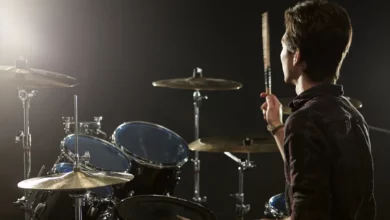
We may earn a commission from the affiliate links on this site. Learn more›
By Matty Allen
Maybe just reading the word makes your palms begin to sweat as your sympathetic nervous system kicks into gear. For many new drum set players, an audition is the intersection of stage fright, fear of rejection, and *gulp* sight-reading.
But before you click away from this page in terror, take a deep breath.
Hold it.
Don’t worry. We are going to get through this together. I will walk you through a typical drum set audition format and give you some advice for how you can adequately prepare yourself, impress the judges, and (hopefully) land the gig!
What Does a Drum Audition Consist Of?
A typical audition usually includes the following components:
- Sight Reading
- Genre Specific Proficiency
- Playing with Other Musicians
- A Prepared Solo (typically not included in drum set auditions. You will be informed ahead of time if you need to prepare a solo)
**Disclaimer: Audition formats vary depending on what the audition is for and who the judges are. This article is based on my personal experiences auditioning for several different academic ensembles, community bands, and professional event bands.**
Sight Reading

You can expect the sight-reading portion of the audition to go something like this. The judges will direct your attention to a music stand where you will find the sight-reading sheet music face down. The judges will then instruct you to flip the music over, take a few minutes to study it, and then play it to the best of your abilities.
Here are the key elements that the judges are looking for:
- Accuracy – How close did you come to playing what was written on the page?
- Continuity – Did you push through to the end, or did you need to stop and restart.
- Tempo Consistency – Did you keep a steady tempo throughout the excerpt (unless instructed otherwise in the music)?
- Phrasing – Were you able to catch dynamic and stylistic markings the first time through? So with those four items in mind, let’s talk about the winning strategy.
First of all, as soon as the judges give you the go-ahead to flip over the sheet music, you need to identify these key elements: Time signature, repeats, stylistic markings, tempo markings, and dynamics.
Then, look for any specific rhythmic hits or anything that looks like a potential trouble spot. Take your time with this and don’t just dive into playing right away.
Now that you’ve looked over the music for anything that might catch you by surprise, you’re ready to start playing through the excerpt.
Slow down the tempo if the tempo marked is too fast for you to read accurately.
Otherwise, you will have to change tempo or stop and restart mid-read. This will confuse the judges and likely count against you.
Keeping with that theme, It’s always better to recover than restart. It’s tempting to want to start over if you make a mistake while sight-reading, but remember: when you’re playing with a full band, this is not an option. Power through and do your best to recover from any hiccups.
Do your best to follow all repeats, form instructions, and catch as many rhythmic hits as you can. Part of your job as a drum set player is helping to guide the band through the form. Therefore, it is vital to demonstrate that you can guide YOURSELF through the form.
Don’t overlook the written dynamics. In addition to showing attention to detail and demonstrating control over your instrument, dynamics can help both you and the judges keep track of where you are in the music. I even recommend exaggerating the dynamics to ensure that the judges don’t miss them.
If you’re new to sight-reading, it can seem overwhelming at first, but don’t worry! With a little time and dedicated practice leading up to your audition, you can make drastic improvements to your sight-reading skills. Get your hands on drum charts you aren’t familiar. Record yourself sight-reading a different one every day with your phone camera or voice memo app.
After each attempt, listen back to the recording with the sheet music in hand and try to figure out where your strengths and challenges are so you know where to focus your practice.
Genre Specific Proficiency
This one is pretty straightforward. Can you play the style of music that the band requires? Figure out which relevant genres you may be asked to perform and spend some of your practice time reviewing each genre’s basics.
Let’s say, for example, that you’re auditioning to be in a jazz group. The judges will ask you to demonstrate a few different jazz grooves such as up-tempo swing, medium swing, brush ballads, and some Latin jazz feel.
If you’re auditioning as a drummer for a cruise ship band or a wedding band, you’ll probably need to demonstrate genres like pop, rock, funk, country, blues, and disco.
During this portion, you want to stick to a nice, steady, solid pocket and not fill around too much. The judges are more concerned with your ability to groove in this genre than what kind of chops you have.
If you do throw in a fill or two, make sure that it is appropriate to the genre that you’re playing. For example, if you play an aggressive rock fill during a jazz ballad, it will count against you.
Playing with Other Musicians

Gelling with other performers is one of the most critical parts of a drum set audition. Fortunately, it’s also the most fun! In this portion, one or more judges will play with you on an instrument of their choosing (usually keyboard or bass) to evaluate your onstage communication and pocket lockup.
Much like the genre proficiency section, the music you play with the judges will depend on what type of band you’re auditioning to play with. If you’re auditioning for a jazz band, you can expect to play a common jazz standard or something out of the real book.
What’s most important during this section of the audition, aside from laying down the most killin’ groove possible, is catching cues from the other musicians.
The judges want to evaluate whether you’re able to support your fellow band members when you’re on stage. Make sure you’re paying attention to the judge’s body language and any hand signals they send your way. That being said, don’t be afraid to let loose a little bit. If you got chops, feel free to flex them in moderation as long as it’s appropriate to what’s happening between you and the judges.
Prepared Solo
Because the role of a drummer is vastly different from that of a more melodic instrument, prepared solos are not typically included as part of drum set auditions.
However, if you are required to prepare a solo ahead of time, make sure you bring an extra copy of your sheet music for the judges so they can follow along.
Additional Tips
Dress to Impress. Like a job interview, a big part of a successful audition is leaving a positive impression on the judges. Business casual is a good fallback.
Be respectful and polite. Like your outfit, this will help you leave a good impression and demonstrate how awesome it would be to have you as a band member.
Arrive early and try to get in a proper warm-up. The last thing you want is to stress about being late on top of stressing about the audition itself. Also, It’s no fun to audition with stiff chops. Arriving early allows you to time mentally and physically prepare yourself for a successful audition.
Don’t panic if something goes wrong during the audition. It’s hard for me to think of an audition where I didn’t feel like I messed up somehow. Don’t worry, even though your mistakes may feel mortifying to you, they are way less noticeable from a listener’s perspective.
Also, there’s no need to apologize to the judges if you stumble. They are more interested in how you recover from your mistakes than the actual errors themselves.
Don’t take it personally if you get rejected. Rejection sucks, there’s no way around it. If you don’t make it past the audition, it doesn’t mean that you’re a failure or should stop trying.
Focus on what you learned from the experience and use it to become an even better drummer. The more you practice and the more you go through the audition process, the easier auditioning will become!

Matty Allen is a session drummer and drum set instructor from Wisconsin specializing in jazz, R&B, hip hop, indie, pop, disco, gospel, and funk.
Follow Matt on Instagram: @mattplaydrum



